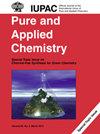从普达植物(Artocarpus kemando Miq.)
IF 2
4区 化学
Q3 CHEMISTRY, MULTIDISCIPLINARY
引用次数: 0
摘要
在这项研究中,成功地从普达植物(Artocarpus kemando Miq.)的根部木材中分离出了 Artocarpin 化合物,随后进行了抗糖尿病和抗金黄色葡萄球菌和伤寒沙门氏菌的测试。分离过程包括使用甲醇浸泡,然后使用柱层析进行分离和纯化。化合物的纯度是通过薄层色谱法和熔点测量确定的。随后通过紫外-可见光谱和红外光谱对化合物进行了表征。分离出的化合物为黄色无定形固体,熔点为 168.7-173.6 ℃。使用浓度为 250、500、750 和 1000 ppm 的化合物对α-淀粉酶进行了抗糖尿病试验。使用 750 ppm 的化合物时,抑制率最高,为 43.33 ± 0.02 %,IC50 值为 32 661.08 ppm。抗菌测试的浓度变化为 0.3、0.4 和 0.5 毫克/盘。金黄色葡萄球菌和伤寒杆菌在 0.5 毫克/盘的浓度下表现出较高的抑制率,抑制区直径分别为 8 毫米和 7 毫米(中等)。本文章由计算机程序翻译,如有差异,请以英文原文为准。
Antidiabetic and antibacterial activities of artocarpin: a flavonoid compound isolated from the root wood of the Pudau plant (Artocarpus kemando Miq.)
In this study, artocarpin compound was successfully isolated from the root wood of the Pudau plant (Artocarpus kemando Miq.) and subsequently tested as antidiabetic and antibacterial agent against Staphylococcus aureus and Salmonella typhi . The procedure applied for isolation involved maceration using methanol followed by partition and purification using column chromatography. The purity of the compound was determined using thin layer chromatography and melting point measurement. The compound was subsequently characterized via UV–vis and IR spectroscopy. The compound isolated was obtained as a yellow amorphous solid and has melting point of 168.7–173.6 °C. The antidiabetic tests were performed against α-amylase enzyme, using the compound with the concentrations of 250, 500, 750, and 1000 ppm. The highest inhibition percentage of 43.33 ± 0.02 % was achieved with the use of 750 ppm of the compound and the IC50 value is 32 661.08 ppm. Antibacterial tests were performed with concentration variations of 0.3, 0.4, and 0.5 mg/disc. S. aureus and S. typhi bacteria showed high inhibition at a concentration of 0.5 mg/disc with inhibition zone diameters of 8 and 7 mm, respectively (moderate category).
求助全文
通过发布文献求助,成功后即可免费获取论文全文。
去求助
来源期刊

Pure and Applied Chemistry
化学-化学综合
CiteScore
4.00
自引率
0.00%
发文量
60
审稿时长
3-8 weeks
期刊介绍:
Pure and Applied Chemistry is the official monthly Journal of IUPAC, with responsibility for publishing works arising from those international scientific events and projects that are sponsored and undertaken by the Union. The policy is to publish highly topical and credible works at the forefront of all aspects of pure and applied chemistry, and the attendant goal is to promote widespread acceptance of the Journal as an authoritative and indispensable holding in academic and institutional libraries.
 求助内容:
求助内容: 应助结果提醒方式:
应助结果提醒方式:


